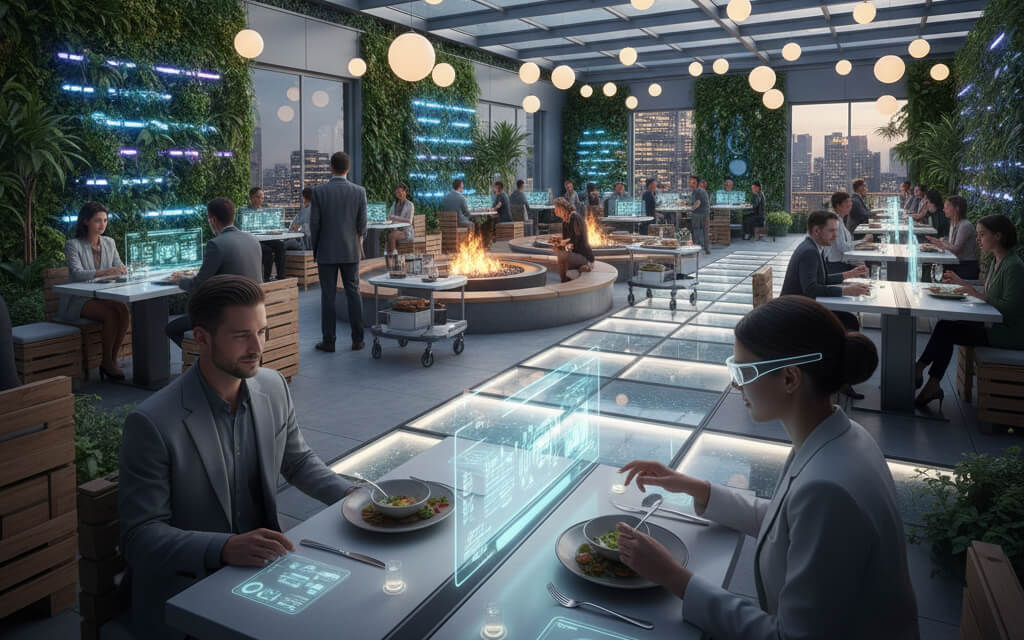October 13, 2025

Once a seasonal perk, outdoor dining has evolved into a core restaurant offering—a necessity turned opportunity. In a world shaped by pandemic recovery, changing consumer expectations, and environmental awareness, outdoor spaces are no longer just patios; they’re brand statements, technology testbeds, and the heart of hospitality’s human connection.
Let’s explore how restaurants are transforming outdoor dining into an immersive, data-driven, sustainable experience.
Outdoor dining’s original rise was rooted in social distancing, but it quickly became a powerful branding tool. Now, outdoor spaces are storytelling environments—customized with textures, lighting, and sound that complement the food and enhance emotional connection.
Smart restaurateurs use customer data to inform every decision—from menu tweaks to layout design. For instance, insights into weather-related sales, preferred dining times, or popular dishes during golden hour can help shape patio layouts and menu offerings.
Using Customer Data to Make Smarter Menu Decisions explains how to collect and apply these insights effectively.
By integrating outdoor experiences into the brand’s identity—like showcasing signature cocktails at sunset or seasonal decor changes—restaurants can attract loyal customers year-round.
Tech is no longer limited to the kitchen or POS—it’s now part of the architecture of ambiance. Restaurants are investing in smart design elements that make outdoor dining adaptable and inviting regardless of weather or time of day.
Imagine AI-controlled heating that adjusts based on body proximity, weather-reactive canopies, or lighting that shifts from brunch brightness to dinner romance.
Operationally, outdoor dining also demands POS systems that can handle mobile ordering, multi-zone service tracking, and on-the-go payments.
The Best POS Systems for Small Restaurants in 2025 outlines how modern POS systems support seamless service even in open-air settings.
This fusion of design and digital infrastructure makes the guest experience smooth—and memorable.
In 2025, restaurants are embracing multi-sensory outdoor experiences to create emotional connections and encourage social sharing.
Tactics include:
Visual storytelling is especially potent outdoors. Think sunset lighting on a charcuterie board or glowing cocktails under Edison lights. These naturally photogenic moments boost user-generated content, increasing a restaurant’s organic reach online.
The Science of Food Photography for Restaurant Websites shows how visual appeal translates into digital engagement and ROI.
Great outdoor design isn’t just functional—it’s felt by guests on every sensory level.
Today’s diners care deeply about sustainability, and your outdoor space is one of the most visible places to show it. Whether it's reclaimed wood furniture, solar-powered lighting, or drought-resistant landscaping, your design can reflect a broader environmental commitment.
Sustainable practices also improve brand storytelling. Diners are more likely to support businesses that match their values—especially if those values are visible in the dining space.
Digital platforms help amplify this message.
Seasonal Campaigns That Drive Website Traffic and Reservations can help promote your sustainability story while increasing bookings.
Whether it’s a green wall, a rainwater collection feature, or a low-waste drink program, outdoor dining is your chance to make eco-efforts part of the experience.
Outdoor dining isn’t just a business function—it’s a community function.
Sociologists call it the “third place”—a space between work and home where people feel seen, comfortable, and connected. Restaurants that build cozy fire pits, host live acoustic sets, or create lounge-style seating areas are turning patios into modern-day town squares.
This also helps differentiate your brand from delivery-only competitors and ghost kitchens.
Ghost Kitchens Explained for Small Restaurant Owners discusses how physical spaces can create emotional connections that virtual ones can't.
By fostering belonging, not just consumption, you turn a patio into a loyalty engine.
The line between digital and physical dining experiences has all but disappeared.
QR code menus, AR-enhanced wine lists, and real-time weather menus (think: “warm drink specials” when temps drop) blend convenience with creativity.
This is especially important for attracting guests browsing online. The way you present your outdoor space on your website, Google listing, or social media can be the deciding factor in whether someone books.
The Most Common Restaurant Website Mistakes (and How to Fix Them) reveals how to showcase your space and avoid digital missteps.
Platforms like RocketPages help restaurants design digital experiences that match their physical charm—through better photos, location-based SEO, and seamless booking tools.
In 2025 and beyond, outdoor dining isn’t optional—it’s central to the restaurant brand, guest experience, and revenue strategy.
Restaurants that merge tech with ambiance, use data to inform design, and tell a cohesive sustainability story will lead the pack.
Because the future of outdoor dining isn’t just about tables under the sky—it’s about crafting open, connected, human-centered spaces that people return to again and again.
Stay up to date with the latest tips, expert insights, product reviews, and step-by-step guides to help you grow, create, and succeed—no matter your industry or passion.